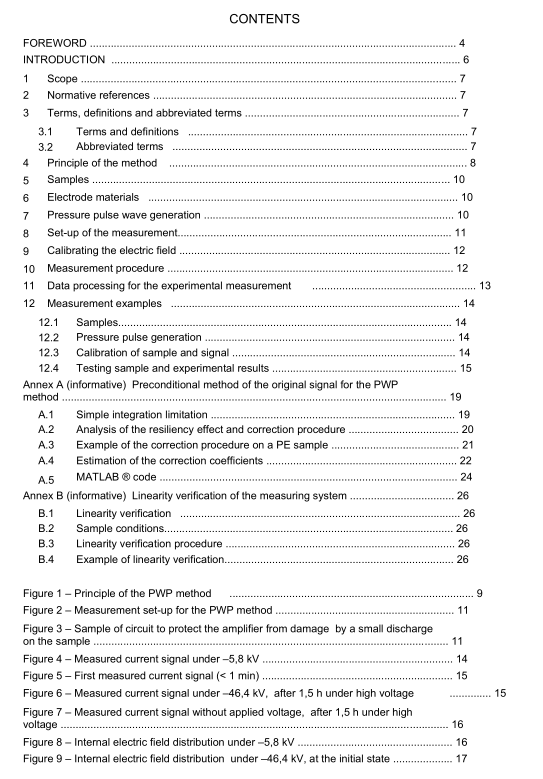IEC TS 62836 pdf – Measurement of internal electric field in insulating materials – Pressure wave propagation method

IEC TS 62836 pdf – Measurement of internal electric field in insulating materials – Pressure wave propagation method
1 Scope
This document provides an efficient and reliable procedure to test the internal electric field inthe insulating materials used for high-voltage applications, using the pressure wave propagation(PwP) method. lt is suitable for a sample with homogeneous insulating materials and an electric
field higher than 1 kV/mm,but it is also dependent on the thickness of the sample and thepressure wave generator.
2Normative references
There are no normative references in this document.
3Terms,definitions and abbreviated terms
For the purposes of this document, the following terms, definitions and abbreviated terms apply.
ISO and lEC maintain terminological databases for use in standardization at the followingaddresses:
. IEC Electropedia: available at http://www.electropedia.orgl
-Iso Online browsing platform: available at http://www.iso.orglobp3.1Terms and definitions
3.1.1
pressure wave propagationPwP
pressure wave that is propagated in a material containing electric charges and measurementof the induced electric signal from electrodes
3.2Abbreviated terms
cBcarbon black
EVAethylene-vinyl acetateLDPE low density polyethyleneLIPPlaser induced pressure pulsePEpolyethylene
PIPPpiezoelectric induced pressure pulsePMMApoly (methyl methacrylate)
PWPpressure wave propagationS/Nsignal to noise ratio
4Principle of the method
The principle of the PwP method is shown schematically in Figure 1.
The space charge in the dielectric and the interface charge are forced to move by the action ofa pressure wave. The charge displacement then induces an electrical signal in the circuit which
is an image of the charge distribution in short-circuit current measurement conditions. Theexpression for the short-circuit current signal with timet is
lj = ogf aa(e ) or(xi) dx ,
where
E(x)is the electric field distribution in the sample at position
is the thickness of sample;
p(t, t)is the pressure wave in the sample,which depends on the electrode materials,
dielectric sample material, the condition of coupling on the interface, etc.;
c
is the sample capacitance without the action of a pressure wave.
Co depends on the thickness of the sample, and its surface area which is equal to the area ofaction of the pressure wave.
The constant B=x(1-a / : only depends on the characteristics of the dielectric materials. Inthis formula, is the coeficient of compressibility of the material,: is the permittivity of thematerial and a is the coefficient of electrostriction of the material.For heterogeneous dielectric
materials,B is a function of space.For homogeneous dielectric materials,B is not a function ofspace and can be put outside of the integral. ln this proposition, only homogeneous dielectric
materials are considered, so is a constant.
In Equation (1), the electric field distribution can be obtained if it is deconvolved.
The applied pressure wave can be generated by different techniques, but the same kind of analysis can be done for any of these techniques. The main practical PWP method can be divided into two ways: a pressure pulse is induced by a powerful laser pulse, a technique called LIPP method, and a pressure pulse generated by a piezoelectric device, a technique called PIPP. The sensibility and resolution of the PWP method depends mainly on the amplitude and width of the pressure pulse. The advantage of the LIPP method is to produce highly sensitive measurements without contact. The advantage of the PIPP method is to obtain the measurement with a high measuring rate and allow a cost measurement system.
5 Samples A dielectric insulating material is suggested, for example polyethylene, with a thickness of 1 mm or 2 mm planar plaque sample with a diameter sufficiently large to avoid edge discharges, typically larger than 20 cm with 5 cm centred electrodes for 60 kV. 6 Electrode materials The selection of electrode materials depends on the method of the generation of the pressure pulse wave. Usually, semi-conductive electrodes with ethylene-vinyl acetate (EVA) + carbon black (CB) or polyethylene (PE) + carbon black (CB) are used. For laser PWP (also called LIPP), the suitable thickness of the semi-conductive electrode is about 0,5 mm, and it shall be less than 1 mm. If different materials are used for the electrode and the insulator, the transit time of the pressure wave through the electrode should be at least half the one in the insulator to avoid spurious echoes. It is important to keep good contact between the electrode and the insulator. It is recommended to use the hot-press method for marking the electrode on the sample.
7 Pressure pulse wave generation The suggested pressure pulse wave should have a 20 ns to 50 ns duration, and a 1 MPa to 10 MPa amplitude. It can be produced by a piezoelectric driven device, or by a powerful pulsed laser. If a powerful laser is used, the suggested energy is about 300 mJ to 500 mJ per pulse with a 3 ns to 7 ns duration.









